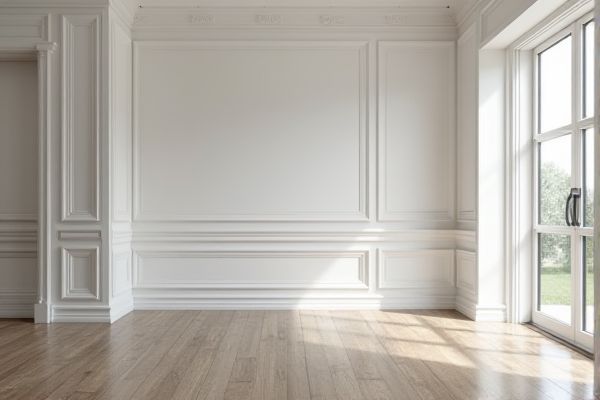
Decorative molding enhances the architectural detail of a room by adding intricate profiles and texture along walls or ceilings, while shiplap offers a clean, horizontal plank design that brings a rustic or modern farmhouse feel to any space. Understanding the unique benefits of decorative molding versus shiplap can help you choose the perfect style for Your home's interior--explore the rest of the article to find out more.
Table of Comparison
| Feature | Decorative Molding | Shiplap |
|---|---|---|
| Material | Wood, MDF, or polyurethane | Wood boards, often pine or cedar |
| Purpose | Enhances architectural details and trims | Creates rustic, horizontal wall paneling |
| Installation | Typically nailed or glued on edges, corners, ceilings | Installed as overlapping horizontal planks |
| Style | Traditional, elegant, and formal | Casual, farmhouse, coastal vibes |
| Cost | Moderate to high depending on materials and design | Low to moderate, depends on wood type and labor |
| Durability | Good, but can be susceptible to dents or moisture | Durable, especially when sealed properly |
| Maintenance | Requires occasional repainting or repair | Needs sealing and cleaning to prevent wear |
Introduction to Decorative Molding and Shiplap
Decorative molding enhances interior aesthetics by adding intricate trim and profiles to walls, ceilings, and cabinetry, offering classic or contemporary design elements. Shiplap features horizontally installed wooden boards with distinctive grooves that create a clean, rustic, and textured wall surface popular in farmhouse and coastal interiors. Both materials serve functional purposes, such as wall protection and concealment of imperfections, while significantly influencing architectural style and ambiance.
Key Differences Between Decorative Molding and Shiplap
Decorative molding, typically made from wood or MDF, serves as an ornamental trim that enhances architectural details by framing walls, ceilings, and doors. Shiplap consists of horizontal wooden planks with a distinctive rabbet joint, creating a tight, weatherproof seal often used for interior accent walls or exterior siding. The key differences lie in function and appearance: decorative molding emphasizes intricate, decorative profiles, while shiplap provides a rustic, linear texture that combines aesthetic appeal with structural utility.
Aesthetic Appeal: Classic vs. Contemporary
Decorative molding offers a classic, elegant aesthetic that enhances traditional interiors with intricate profiles and refined details. Shiplap provides a sleek, contemporary look characterized by clean, horizontal lines that bring a modern farmhouse vibe to your space. Choosing between the two depends on whether you want your design to emphasize timeless sophistication or a fresh, minimalist appeal.
Installation Process: Complexity and Tools Required
Decorative molding installation involves precise measurements, cutting with miter saws, and nailing or gluing pieces to walls or ceilings, often requiring caulking and painting for a polished finish. Shiplap installation demands wider boards, a level surface, and tools like a nail gun and saw, with careful alignment to create the characteristic overlapping joints that add texture to interiors. Your choice between these options should consider your comfort with detailed trim work versus installing larger planks for subtle, rustic appeal.
Material Options for Molding and Shiplap
Decorative molding is typically crafted from wood, MDF, polyurethane, or PVC, offering versatility in texture, finish, and durability for various interior styles. Shiplap is commonly made from solid wood, plywood, or engineered wood, characterized by its overlapping boards that create a distinctive, rustic texture ideal for feature walls. Both materials provide diverse options that can be customized to enhance architectural details and complement design aesthetics.
Durability and Maintenance Comparisons
Decorative molding typically consists of hardwood or composite materials, offering enhanced durability and resistance to minor dings and scratches compared to shiplap, which is often made from softer wood. Shiplap requires more frequent maintenance, such as repainting or resealing, to protect against moisture damage and warping over time. Your choice between the two should consider the level of upkeep you are willing to invest and the environmental conditions of the installation area.
Cost Considerations: Budgeting for Your Project
Decorative molding typically costs between $1 and $5 per linear foot, depending on materials like wood or polyurethane, while shiplap panels range from $2 to $7 per square foot. Installation expenses vary as decorative molding requires precise cuts and joining, often increasing labor costs compared to the simpler, faster installation of shiplap. Budgeting should account for both material quality and labor complexity to ensure a cost-effective project outcome.
Best Applications: Where to Use Each Style
Decorative molding excels in enhancing interior architecture by adding elegance to ceilings, walls, and door frames, making it ideal for formal living rooms, dining areas, and historic restoration projects. Shiplap, with its distinctive horizontal planks and rustic texture, suits casual settings such as farmhouse kitchens, accent walls, and coastal-themed interiors, providing a cozy, textured backdrop. Both materials serve unique aesthetic and functional roles, with molding emphasizing refined detailing and shiplap offering a more laid-back, tactile surface.
Design Impact on Home Value
Decorative molding enhances your home's elegance by adding intricate architectural details that appeal to traditional and upscale buyers, often increasing property value. Shiplap creates a rustic, modern farmhouse aesthetic, which can attract buyers seeking trendy, casual designs and improve resale appeal in those markets. Choosing between decorative molding and shiplap depends on your target buyer's preferences and the overall style cohesion to maximize your home's market value.
Choosing the Right Option for Your Space
Decorative molding enhances architectural details with intricate designs, adding elegance and character to traditional or formal spaces, while shiplap offers a sleek, rustic charm ideal for modern farmhouse or coastal interiors. When choosing the right option for your space, consider the room's style, desired texture, and maintenance requirements; molding suits detailed, polished environments, whereas shiplap excels in creating casual, textured walls. Evaluate lighting, color schemes, and overall home design to ensure the chosen material complements and elevates your interior aesthetic effectively.
 homyna.com
homyna.com